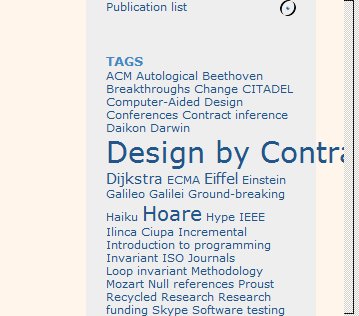Statement Considered Harmful
I harbor no illusion about the effectiveness of airing this particular pet peeve; complaining about it has about the same chance of success as protesting against split infinitives or music in restaurants. Still, it is worth mentioning that the widespread use of the word “statement” to denote a programming language element, such as an assignment, that directs a computer to perform some change, is misleading. “Instruction” is the better term.
A “statement” is “something stated, such as a single declaration or remark, or a report of fact or opinions” (Merriam-Webster).
Why does it matter? The use of “statement” to mean “instruction” obscures a fundamental distinction of software engineering: the duality between specification and implementation. Programming produces a solution to a problem; success requires expressing both the problem, in the form of a specification, and the devised solution, in the form of an implementation. It is important at every stage to know exactly where we stand: on the problem side (the “what”) or the solution side (the “how”). In his famous Goto Statement Considered Harmful of 1968, Dijkstra beautifully characterized this distinction as the central issue of programming:
Our intellectual powers are rather geared to master static relations and our powers to visualize processes evolving in time are relatively poorly developed. For that reason we should do (as wise programmers aware of our limitations) our utmost to shorten the conceptual gap between the static program and the dynamic process, to make the correspondence between the program (spread out in text space) and the process (spread out in time) as trivial as possible.
Software verification, whether conducted through dynamic means (testing) or static techniques (static analysis, proofs of correctness), relies on having separately expressed both a specification of the intent and a proposed implementation intended to realize that intent. They have to remain distinct; otherwise we cannot even define what it means that the program should be correct (correct with respect to what?), and even less what it means to validate the program (validate it against what?).
In many approaches to verification, the properties against which we validate programs are called assertions. An assertion expresses a property that should hold at some point of program execution. For example, after the assignment instruction a := b + 1, the assertion a ≠ b will hold. This notion of assertion is used both in testing frameworks, such as JUnit for Java or PyUnit for Python, and in program proving frameworks; see, for example, the interactive Web-based version of the AutoProof program-proving framework for Eiffel at autoproof.sit.org, and of course the entire literature on axiomatic (Floyd-Hoare-Dijkstra-style) verification.
The difference between the instruction and the assertion is critical: a := b + 1 tells the computer to do something (change the value of a), as emphasized here by the “:=” notation for assignment; a ≠ b does not direct the computer or the computation to do anything, but simply states a property that should hold at a certain stage of the computation if everything went fine so far.
In the second case, the word “states” is indeed appropriate: an assertion states a certain property. The expression of that property, a ≠ b, is a “statement” in the ordinary English sense of the term. The command to the computer, a := b + 1, is an instruction whose effect is to ensure the satisfaction of the statement a ≠ b. So if we use the word “statement” at all, we should use it to mean an assertion, not an instruction.
If we start calling instructions “statements” (a usage that Merriam-Webster grudgingly accepts in its last entry for the term, although it takes care to define it as “an instruction in a computer program,” emphasis added), we lose this key distinction.
There is no reason for this usage, however, since the word “instruction” is available, and entirely appropriate.
So, please stop saying “an assignment statement” or “a print statement“; say “an assignment instruction” and so on.
Maybe you won’t, but at least you have been warned.
![]() This article was first published in the “Communications of the ACM” blog.
This article was first published in the “Communications of the ACM” blog.

 Informatics Europe
Informatics Europe LASER summer school
LASER summer school Propulsion Academy
Propulsion Academy